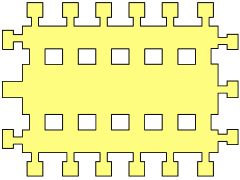Heritage Building Information Modelling (HBIM)
HBIM has established itself in recent years as an innovative tool to revolutionise the documentation, analysis and management of cultural heritage sites. With its roots in classic Building Information Modelling (BIM), HBIM goes beyond purely geometric 3D modelling by integrating historical, semantic and material data. This methodology opens up new perspectives for archaeology by combining technological precision with the complexity of historical interpretation.
Traditional archaeological practice has often been characterised by destructive excavation methods and fragmented documentation. HBIM offers an approach that not only stores data, but also analyses, visualises and preserves it for future generations. Especially in archaeology, where the context of finds is crucial, HBIM represents a paradigm shift.
What is HBIM?
HBIM is a specialised extension of BIM that was developed specifically for historical and cultural buildings. The focus is not only on the geometry, which utilises digital technologies such as laser scanning, photogrammetry and point cloud processing, and the materials of the buildings, but also on the historical information:
- Historical information: integration of texts, plans, documents, construction phases, archaeological interpretations and cultural contexts.
- Semantic data: Detailed descriptions of building materials, conditions and damage, as well as utilisation contexts.
- Dynamic use: Enabling construction phase analyses and virtual reconstructions.
The HBIM workflow comprises several steps:
- Data acquisition: Terrestrial laser scanning (TLS) for point clouds, photogrammetry and UAV-based technologies provide the basis.
- Data processing: Point clouds are segmented, modelled and enriched with metadata.
- True orthophotos are created from the image data for the metrically accurate analysis of damage.
- Modelling: Parametric modelling enables the creation of intelligent objects.
- Data management: Integration of open standards such as IFC for interoperability.
- Automatic detection and measurement of cracks and material damage using the HED model (Holistically Nested Edge Detection).
- Statistical analysis of the damage (e.g. area, extent, typology) and integration into the HBIM.
The importance of HBIM in archaeology
The use of HBIM has developed further in recent years, but is not yet fully established.
However, HBIM offers considerable advantages in archaeological research:
- Documentation: precise digital models preserve the current condition of a building.
- Analysis: Models can be used to analyse building materials, structural loads and construction phases.
- Reconstruction: Hypothetical models allow lost building phases or original designs to be visualised.
- Conservation: Data supports the development of sustainable restoration plans.
- Public relations: HBIM can be made accessible to a wider public through immersive technologies such as AR/VR.
State of research and practice
The application of HBIM is currently at a development stage. However, several important case studies show the potential of this technology:
- City Walls of Pisa: Automated workflow to create a comprehensive model documenting both geometries and material conditions.
- Casa de Pilatos, Seville: Integration of TLS and parametric modelling to capture complex geometries.
- AlDeir-Monument, Petra: Combination of deep learning and HBIM to analyse damage and create new parametric libraries.
Despite these advances, the application is often limited to pilot projects due to technological, financial and methodological challenges.
Opportunities through HBIM
- Improved decision-making: By integrating geometry and semantic data, HBIM provides a solid basis for well-founded restoration decisions.
- Interdisciplinary collaboration: HBIM facilitates collaboration between architects, historians, archaeologists and engineers.
- Public communication: VR/AR applications make HBIM models accessible to museums, educational institutions and the public.
Challenges and problems
- Technological barriers:
Lack of standardisation makes data exchange difficult.
The creation of complex models requires specialised software and technical expertise.
Existing BIM libraries are designed for modern buildings and do not cover the complex, irregular structures of historical architecture.
Manual modelling and damage detection are time-consuming and subjective. - Funding and resources:
High costs for hardware, software and personnel limit the application to well-funded projects. - Data quality:
Missing or uncertain data sources, especially for destroyed or heavily weathered buildings.
